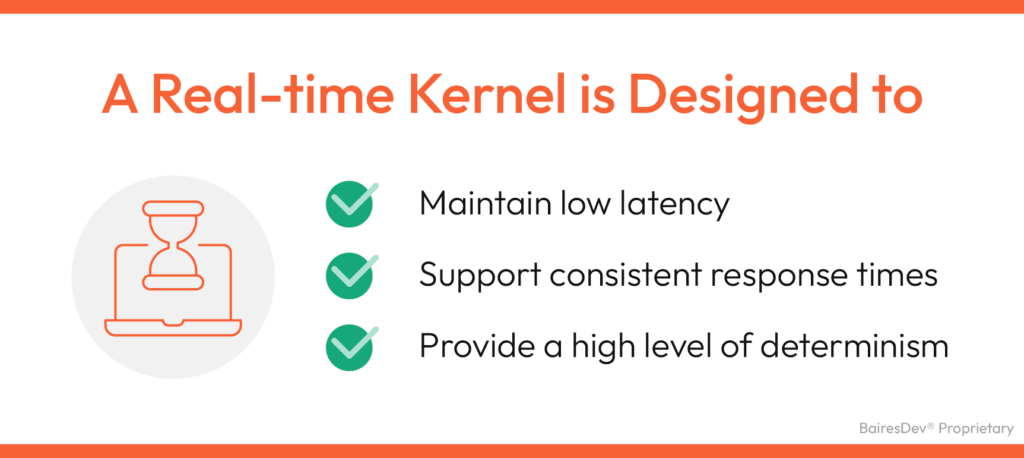Performance isn’t always easily measured. Part of the reason for this is the use case. Take, for instance, the desktop vs. server use case. You might think a desktop could benefit from the same technology that helps boost a server’s performance such that it can work with massive troves of data faster and more reliably.
After all, isn’t fast, well, fast? Sure. But not every need for speed is the same. Case in point, the real-time kernel.
What is a Real-Time Kernel?
Back in June of 2023, Canonical Announced it was releasing Real-Time Linux, which took advantage of a real-time kernel.
In this LinkedIn discussion, Pablo Mesa, COO of Ascend, says of real-time kernels (and real-time operating systems), “RTOSs also excel in optimizing resource utilization. By intelligently scheduling tasks based on priority, urgency, and duration, they improve efficiency and ensure optimal performance. This capability is valuable in scenarios where time is of the essence, such as industrial control systems.”
But what exactly is a real-time kernel? Essentially, a real-time kernel (RTK) is all about preventing latency (delay). An RTK manages the time of a CPU to ensure that time-critical events can be processed with a high level of efficiency. This doesn’t mean an RTK is superior to a traditional kernel but, instead, it focuses on very specific business or system requirements.

What does that all mean? Simply put, it means an RTK is very predictable. This is especially important with use cases such as IoT, big data, machine learning, artificial intelligence, process automation, telecommunications, and robot control systems. An RTK might be a solid option in any use case where latency can be a problem.
However, not every type of technology is suitable for every use case. An RTK is a perfect example of that. Although you might think minimal (to near-zero) latency would be great for just about any computer that requires very fast processing, that assumption would be incorrect.
The disadvantages of an RTK clearly illustrate it’s not ideal for every use case. These drawbacks include:
- Requires far more (and highly complex) configurations to be useful
- Is not supported by all hardware
- Is not suitable for software development or debugging
- Is less efficient with multi-tasking
- Can be unpredictable if not configured and deployed properly
- Doesn’t function well with many user applications
Although there are some desktop use cases where an RTK can be advantageous (such as audio and video production), the apps used for those instances must support an RTK, and there’s no guarantee of that.

One of the biggest issues with using an RTK as a desktop solution is that general-purpose operating systems require features and characteristics that cannot function with the real-time latency guarantees found in an RTK. Because of the way it works, tasks with low priority tend to be ignored for long periods of time. A desktop OS must be able to function with a multitude of applications from different vendors while still delivering an acceptable level of performance.
An RTK is too specific for that, and a general-purpose OS would wind up performing poorly under those conditions.
However, a purpose-specific OS (such as those for IoT devices) can greatly benefit from RTKs because of the inherent low latencies and scheduling priorities. In the end, it’s not just about speed but also process timing and equability.
Interested in Linux development? Learn more about our software development technologies.
The Benefits of a Real-Time Kernel
When you see the benefits of an RTK, it should all fall into place for you and/or your development team. Those benefits include:
- All processes are guaranteed to return or fail within a certain amount of time.
- Deterministic task scheduling means that tasks are always executed in a timely and predictable manner.
- Reduced latency dramatically minimizes the time between an event occurrence and the associated response.
- Task prioritization allows an admin or developer to assign specific priorities to ensure all critical tasks are executed first.
- Resource management (such as memory allocation, inter-task communication, and task synchronization) is greatly improved.
- Higher fault tolerance means errors and exceptions are handled more gracefully, which improves the reliability of a system.
- Portability means RTKs are available for numerous platforms and architectures.
- Modular by design means features and components can be added or removed as needed.
- High scalability means you can scale depending on your needs.

When Should Your Company Use a Real-Time Kernel?
As we’ve already said, not every use case is ideal for an RTK. Ultimately, it boils down to latency and predictability. If you have a scenario where you need data processed in real-time (such as with edge computing), an RTK might be the best option.
These types of use cases are highly specialized, such that you have a few specific processes that must have a very high priority.
Some very obvious examples of where an RTK can be successfully deployed include:
- Industrial automation
- Autonomous driving
- Health care (such as life support devices)
- Smart energy grids
- Aerospace and defense
- Telecommunications (such as call processing)
- Financial trading
- Multimedia and gaming
The Pitfalls of Real-Time Kernels
The biggest issue with employing an RTK is having the engineers, admins, and developers with the skills to properly configure and deploy them. Although you can find operating systems that are purpose-built as real-time platforms if your use case doesn’t exactly fit that purpose, you’ll have to do some optimizations. Without a trained staff, that can be a challenge.
And, of course, as we mentioned earlier, RTKs are not general purpose. If you deploy an RTK for a general purpose (hoping to benefit from the extremely low latency), you’ll find many apps and services experience a dramatic degradation in performance.
Also, the cost of a real-time kernel can be prohibitive. Given you won’t be running such a kernel on commodity hardware, you have the up-front cost of systems that can benefit from these types of kernels.
RTKs can also be very limiting. As we already mentioned, these are often very purpose-specific, so your admins and developers have to be able to work with a kernel that can have a very narrow focus. At the same time, RTKs are often very inflexible. So, if you think you’ll employ an RTK and bend it to meet needs outside of its intended purpose, you’ll find the task to be quite challenging.
Finally, although you can wind up with a highly performant system with an RTK, the time to delivery can be drawn out. Because RTKs require a very special skill set, it will take your development teams longer to get everything production ready … especially if they are learning as they go.
Conclusion
Real-time kernels offer some amazing advantages for specific use cases and if your company falls under the auspices of such a use case, an RTK could be the ideal option. And given you can find plenty of Linux distributions that offer RTK options, you won’t have to spend an inordinate amount of your budget on the OS.






